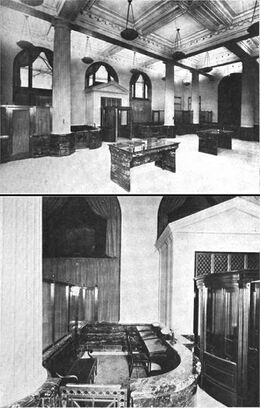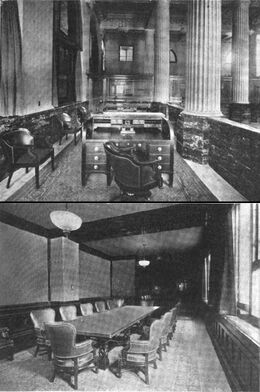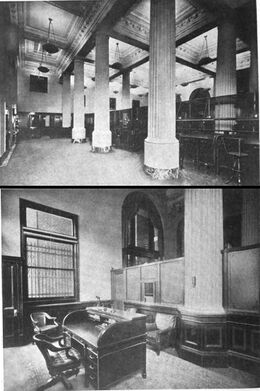Second National Bank, New Haven, CT (Charter 227)
Second National Bank, New Haven, CT (Chartered 1864 - Open past 1935)
Town History
New Haven is a city in New Haven County, Connecticut. It is located on New Haven Harbor on the northern shore of Long Island Sound and is part of the New York City metropolitan area. With a population of 135,081 as determined by the 2020 U.S. census, New Haven is the third largest city in Connecticut after Bridgeport and Stamford, the largest city in the South Central Connecticut Planning Region, and the principal municipality of Greater New Haven, which had a total 2020 population of 864,835. Prior to 1960, it was the county seat of New Haven County until the county governments were abolished that year.
New Haven was one of the first planned cities in the U.S. A year after its founding by English Puritans in 1638, eight streets were laid out in a four-by-four grid, creating the "Nine Square Plan". The central common block is the New Haven Green, a 16-acre square at the center of Downtown New Haven. The Green is now a National Historic Landmark, and the "Nine Square Plan" is recognized by the American Planning Association as a National Planning Landmark.
New Haven is the home of Yale University, New Haven's biggest taxpayer and employer, and an integral part of the city's economy. Health care, professional and financial services and retail trade also contribute to the city's economic activity.
The city served as co-capital of Connecticut from 1701 until 1873, when sole governance was transferred to the more centrally located city of Hartford. New Haven has since billed itself as the "Cultural Capital of Connecticut" for its supply of established theaters, museums, and music venues. New Haven had the first public tree planting program in America, producing a canopy of mature trees (including some large elms) that gave the city the nickname "The Elm City".
New Haven had nine National Banks chartered during the Bank Note Era, and all nine of those banks issued National Bank Notes. New Haven also had nine Obsolete Banks that issued Obsolete Bank Notes during the Obsolete Bank Note Era (1782-1866).
Bank History

- Chartered February 3, 1864
- Succeeded Elm City Bank
- Bank was Open past 1935
On July 11, 1854, subscription books were opened for the capital stock of the Elm City Bank of New Haven at the office of the Mechanics' and Working Men's Mutual and Savings Bank and Building Association, opposite the Mechanics' Bank. The commissioners were Leverette Candee, Seymour W. Baldwin, Adna Whiting, Dyer Ames, Jr., and Henry Trowbridge.
In June 1855, of the five banks chartered at the last session of the legislatures, only two had been organized--the Elm City and the Stafford. The Elm City Bank was not yet in operation. In November 1855, Francis E. Harrison, late Clerk of the House of Representatives, was appointed teller of the new Elm City Bank.
In September 1859, Mr. D.R. Satterlee, the President of the New Haven Insurance Company, resigned his post of cashier of the Elm City Bank to take effect October 1st. Mr. Israel R. Ward, the teller, was appointed as the new cashier and E.C. Scranton was president.
In February 1860, the Elm City Bank purchased the building occupied by the New Haven Post Office for $28,000. Also, E.C. Scranton was back in the Senate having previously served in that body in 1841, '46, '50, and '51.
In January 1864, the bank voted to increase its capital to $1,000,000 and to reorganize under the new National Banking Law to take effect about the 1st of February. In February 1864, stockholders of the Second National Bank of New Haven voted to increase their capital to $1,000,000 and elected E.C. Scranton, president; Thomas B. Osborne, vice president; and Israel K. Ward, cashier.
In December 1868, Mr. Edward S. Scranton resigned his position as assistant cashier of the Second National Bank of New Haven to go into business for himself as a private banker. Mr. Charles A. Sheldon, teller of the Mechanics Bank, was appointed to fill his place.
In September 1869, Arthur D. Osborne was elected a director to fill the vacancy caused by the death of his father, Judge Thomas B. Osborne.
In 1873, the Second National erected a new building at the same location on the corner of Union and Chapel Streets.
In February 1880, the bank reported capital stock paid in of $1,000,000, surplus $370,000, undivided profits $27,706.41, circulation $800,000, and deposits of $683,894.60. Total resources amounted to $2,912,216.94. Samuel Hemingway, E.H. Trowbridge, and Arthur D. Osborne were directors attesting to the correctness of the report. I.K. Ward was cashier.
On November 24, 1893, Ezekiel H. Trowbridge died of complications of kidney and liver disease. He was the third son of Henry and Harriet (Hayes) Trowbridge and was born in New Haven on April 21, 1818. At an early age he entered the counting house of his father who was engaged in the West Indies trade. At 19, he was sent to the West Indies to familiarize himself with that part of the business taking with him full power of attorney from the house to transact business. On arriving at his majority he was admitted as a partner into the firm of H. Trowbridge, Sones, and Dwight, afterwards H. Trowbridge & Sons, and on the death of his father in 1849, the firm of H. Trowbridge's Sons was formed by his three brothers, Thomas R., Henry, Winston J., and himself. In 1855, he was an organizer of the Elm City Bank, and was a successful and influential director. He was a director in the New York, New Haven and Hartford Company and vice president of the Shore Line Railroad Co.

Completed in 1913, the new home of the Second National Bank of New Haven, Connecticut, was a simple and dignified, but decidedly pleasing design. The building was eight stories high, rising 112 feet above the curb. The walls of the first story were of granite, the second of terra cotta with the upper and cornice of the same material. The intermediate stories were of dark red Bokhara brick with panes between windows at each floor of terra cotta. The building afforded large floor space enclosed in the 87' 9" X 61' 2" building. Within this space ample provision was made for all departments including a ladies' room customers' rooms, officers' space and private consultation rooms, and an especially large and well-arranged space for the large working force of the bank. The directors' room was particularly fine as furnishings had a mahogany finish. Black and gold marble was employed in constructing the bank counter with a bronze screen above. The safety vault, 18 feet square, was equipped with a bronze entrance door and an emergency door at the rear. Besides the banking rooms, there were 170 modern offices served by three high-speed passenger elevators. The new building was constructed by Messrs. Hoggson Brothers of New York, and this was the second building erected by this firm for the bank.

The officers in 1913 were Samuel Hemingway, president; Arthur D. Osborne and James S. Hemingway, vice presidents; Charles A. Sheldon, cashier; and Eugene G. Allyn, assistant cashier. The directors were Arthur D. Osborne; John L. Billard, president Lyon & Billard Co., Meriden, president Meriden Savings Bank, and director of the N.Y., N.H., & H. R.R. Co.; Justus S. Hotchkiss; Samuel Hemingway, director, Boston & Maine Railroad, Maine Central Railroad, and New Haven Water Co., vice president New Haven Savings Bank; Alfred E. Hammer, treasurer, Malleable Iron Fittings Co., Branford, trustee Connecticut Savings Bank, New Haven; John Brewster Fitch, president, The W. & E.T. Fitch Co., vice president New Haven Savings Bank; Charles S. Mellen; James S. Hemingway, treasurer, New Haven Savings Bank, director, N.Y., N.H. & H. R.R. Co., New Haven Gas Light Co., Security Insurance Co.; Winston J. Trowbridge, assistant treasurer, New Haven Savings Bank, directors, New Haven Gas Light Co., New Haven Water Co.; Charles F. Brooker, Ansonia, president, American Brass Co., vice president, Ansonia National Bank, directors N.Y., N.H. & H. R.R. Co.; Frederick F. Brewster, vice president, W. & E.T. Fitch Co., director N.Y., N.H. & H. R.R. Co., New Haven Gas Light Co.; Richard G. Davis, wholesale merchant, flour, grain and feed. The bank's statement of April 4, 1913, showed capital $750,000, surplus and undivided profits $798,659.78, deposits $2,440,290, and total resources $4,724,150. E.C. Scranton was the first president of the bank and continued to hold the office until his death.[3]
In April 1930, Eugene G. Allyn was elected president by the board of directors. Mr. Allyn was vice president and cashier of the bank and succeeded the late Samuel Hemingway. Louis L. Hemingway, son of Samuel Hemingway, was made chairman of the board of directors, a newly made office.
In January 1943, Frederick E. Hudson was elected vice president and Elwyn H. Cowles was comptroller and cashier.
On June 27, 1961, the consolidation of the Community Bank and Trust Company and the Second National Bank of New Haven was approved, effective June 30. Frederick E. Hudson, president of the Second National would be president of the consolidated bank. Frank C. Rossi, president of Community Bank and Trust would be chairman of a special advisory board for all community bank offices. The merged banks would have total resources of $75 million and capital of more than $6.6 million.
On February 2, 1963, The American Bank and Trust Company of New Haven had the approval of the comptroller of the currency to merge with the Second National Bank of New haven. James J. Saxon, comptroller of the currency, said the merger would make a stronger bank able to achieve economies while competing with the other financial institutions in the city. The two banks would have combined deposits of more than $350 million.
In August 1972, the application to change from a national bank to a state bank was approved by the state banking commission. The change for the bank with assets of over $200 million was the first time in more than 50 years that a bank of its size converted to a state charter. The Second New Haven Bank began Friday, September 1st as the 10th largest of the state's 60 commercial banks and bank holding companies. Besides its headquarters in New Haven, the bank had 17 branches and assets of $215 million on June 30th. John C. Robinson, immediate past president of the Connecticut Bankers' Association was president of Second New Haven.
On December 31, 1978, through the merger of the four subsidiary banks of Colonial Bancorp, Inc., Colonial Bank of Waterbury, Colonial Bank of New Haven, Colonial Bank of Hartford and Colonial Bank of Plainville, Colonial Bank was formed. Other Colonial Bancorp subsidiaries included Colonial Trust Management Corp. Colonial Business and Finance Corp. Policy Advancing Corp. Colbanc Realty Corp. and Colbank Leasing Corp. Francis M. White was Colonial Bancorp chairman and president.
Official Bank Title
1: The Second National Bank of New Haven, CT
Bank Note Types Issued

A total of $15,618,700 in National Bank Notes was issued by this bank between 1864 and 1935. This consisted of a total of 1,894,204 notes (1,894,204 large size and No small size notes).
This bank issued the following Types and Denominations of bank notes:
Series/Type Sheet/Denoms Serial#s Sheet Comments Original Series 4x5 1 - 12700 Original Series 4x10 1 - 17075 Original Series 3x20-50 1 - 7020 Series 1875 4x5 1 - 11753 Series 1875 4x10 1 - 11140 Series 1875 3x20-50 1 - 2491 1882 Brown Back 4x5 1 - 46202 1882 Brown Back 3x10-20 1 - 30445 1882 Brown Back 50-100 1 - 400 1902 Red Seal 4x5 1 - 26000 1902 Red Seal 3x10-20 1 - 21200 1902 Date Back 4x5 1 - 61750 1902 Date Back 3x10-20 1 - 41700 1902 Plain Back 4x5 61751 - 183257 1902 Plain Back 3x10-20 41701 - 104068
Bank Presidents and Cashiers
Bank Presidents and Cashiers during the National Bank Note Era (1864 - 1935):
Presidents:
- Erastus Clark Scranton, 1864-1866
- Samuel Hemingway, (I), 1867-1881
- Arthur Dimon Osborne, 1882-1898
- Samuel Hemingway, (II), 1899-1930
- Eugene Gilbert Allyn, 1930-1935
Cashiers:
- Israel Kimberly Ward, 1864-1882
- Charles Anson Sheldon, 1883-1913
- Eugene Gilbert Allyn, 1914-1930
- Frederic Earl Hudson, 1930-1935
Other Known Bank Note Signers
- No other known bank note signers for this bank
Bank Note History Links
Sources
- New Haven, CT, on Wikipedia
- Don C. Kelly, National Bank Notes, A Guide with Prices. 6th Edition (Oxford, OH: The Paper Money Institute, 2008).
- Dean Oakes and John Hickman, Standard Catalog of National Bank Notes. 2nd Edition (Iola, WI: Krause Publications, 1990).
- Banks & Bankers Historical Database (1782-1935), https://spmc.org/bank-note-history-project
- Litchfield Enquirer, Litchfield, CT, Thu., July 6, 1854.
- Hartford Courant, Hartford, CT, Fri., June 1, 1855.
- Hartford Courant, Hartford, CT, Tue., Nov. 20, 1855.
- Hartford Courant, Hartford, CT, Fri., Sep. 23, 1859.
- Hartford Courant, Hartford, CT, Tue., Feb. 7, 1860
- Hartford Courant, Hartford, CT, Thu., Apr. 26, 1860.
- Hartford Courant, Hartford, CT, Sat., Jan. 30, 1864.
- Hartford Courant, Hartford, CT, Thu., Feb. 4, 1864.
- Hartford Courant, Hartford, CT, Fri., Dec. 4, 1868.
- Hartford Courant, Hartford, CT, Thu., Sep. 30, 1869.
- The Morning Journal-Courier, New Haven, CT, Fri., Feb. 27, 1880.
- The Morning Journal-Courier, New Haven, CT, Fri., Nov. 24, 1893.
- Hartford Courant, Hartford, CT, Fri., Apr. 18, 1930.
- Hartford Courant, Hartford, CT, Mon., Jan. 25, 1943.
- The Bridgeport Post, Bridgeport, CT, Tue., Jan. 27, 1961.
- The Bridgeport Post, Bridgeport, CT, Sat., Feb. 2, 1963.
- Naugatuck Daily News, Naugatuck, CT, Tue., Aug. 29, 1972.
- Hartford Courant, Hartford, CT, Tue., Aug. 29, 1972.
- Record-Journal, Meriden, CT, Thu., Mar. 29, 1979.






